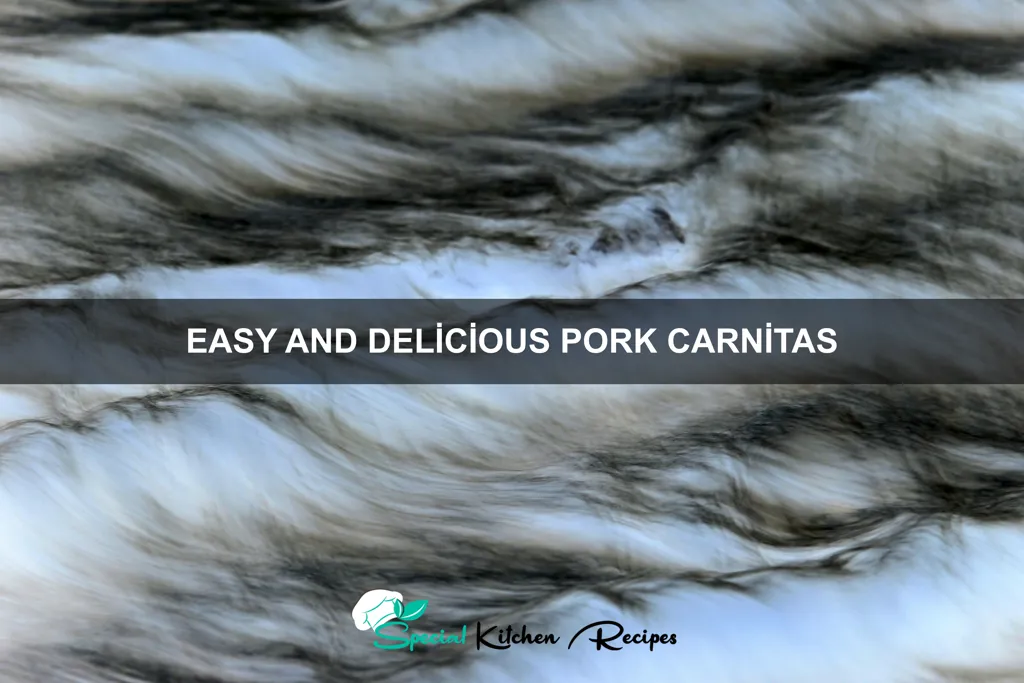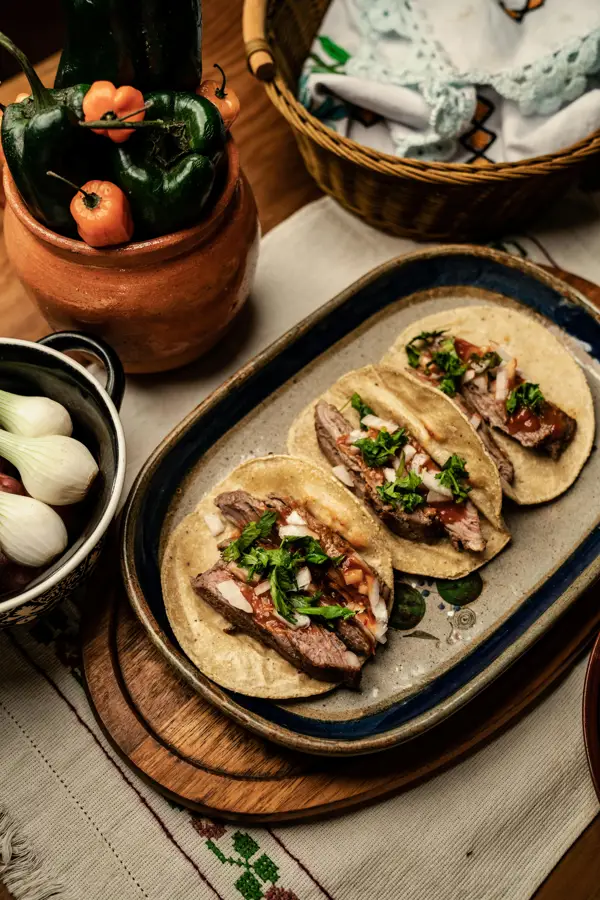Prepare yourself for a culinary journey to the heart of Mexico with our recipe for Easy and Delicious Pork Carnitas! Carnitas, meaning little meats in Spanish, are a beloved dish with a rich history deeply woven into Mexican culture. Originating in the state of Michoacán, these slow-cooked, shredded pork delights have transcended regional boundaries to become a national treasure, enjoyed across Mexico and celebrated globally.
The history of carnitas is as flavorful as the dish itself. While pinpointing an exact origin date is difficult, its roots are firmly planted in the traditional methods of preparing pork using indigenous cooking techniques combined with Spanish influences following the colonization of Mexico. The slow-cooking process, often involving a wood-fired oven or a traditional pitsa (a pit in the ground), allows the pork to become incredibly tender and infused with smoky flavors. This method, passed down through generations, ensures that each bite offers a taste of history.
Carnitas are more than just a meal; they’re a symbol of community and celebration. Frequently served at fiestas and family gatherings, they represent the warmth and generosity of Mexican hospitality. Their popularity is undeniable; a recent study showed that carnitas are among the top three most ordered Mexican dishes in the United States, showcasing their widespread appeal. The versatility of carnitas is another key to their success; they can be enjoyed in tacos, burritos, bowls, or simply as a standalone dish with all the fixings, offering a delightful culinary experience for diverse palates.
Beyond the deliciousness, carnitas offer a wonderful opportunity to explore and appreciate the diversity of Mexican cuisine. Our recipe simplifies the traditional method, making it accessible to home cooks while still capturing the authentic flavors and textures that define this iconic dish. Get ready to experience the magic of carnitas – a taste of history, a celebration of culture, and a delicious adventure for your taste buds!
Ingredients and Measurements
This recipe for Easy and Delicious Pork Carnitas yields approximately 6-8 servings. The beauty of carnitas lies in its adaptability, so feel free to adjust quantities based on your needs. Accurate measurements are crucial for achieving the perfect tender, flavorful pork.
For the Pork:
- 3 lbs boneless pork shoulder (also known as Boston butt). Choose a good quality pork shoulder with some marbling for maximum flavor and tenderness. A cheaper cut might result in drier carnitas.
- 1 large white onion, roughly chopped (approximately 1 ½ cups chopped)
- 4 cloves garlic, minced
- 2 oranges, juiced (approximately ¾ cup fresh orange juice)
- ½ cup chicken broth (low sodium preferred)
- ¼ cup apple cider vinegar
- 2 tablespoons olive oil
- 2 teaspoons ground cumin
- 1 teaspoon smoked paprika
- 1 teaspoon dried oregano
- 1 teaspoon salt
- ½ teaspoon black pepper
- ½ teaspoon cayenne pepper (optional, for a touch of heat)
For Serving (Optional):
- Warm tortillas (corn or flour)
- Your favorite toppings: chopped cilantro, diced white onion, pico de gallo, shredded lettuce, sour cream or Mexican crema, shredded cheese (queso fresco or Monterey Jack), lime wedges
Important Notes on Measurements:
Using a kitchen scale for the pork shoulder will ensure accuracy. For the chopped onion, a rough chop is fine; precise measurements aren’t critical here. Ensure you’re using fresh orange juice for the best flavor; bottled juice will alter the taste. Adjust the cayenne pepper to your preferred level of spiciness. Don’t be afraid to taste and adjust seasoning throughout the cooking process. This is a very forgiving recipe, and small adjustments can make a big difference in the final product.
Pro Tip: For extra flavorful carnitas, consider marinating the pork for at least 4 hours, or even overnight, in a mixture of the orange juice, vinegar, and spices before cooking. This will allow the flavors to penetrate the meat more deeply, resulting in incredibly tender and flavorful carnitas.
Equipment List
Making delicious pork carnitas requires the right tools to ensure even cooking and easy preparation. This equipment list details everything you’ll need, from the cooking vessel to serving utensils. Investing in quality equipment will make the entire process smoother and more enjoyable.
Large Dutch Oven or Heavy-bottomed Pot (6-8 quart): This is crucial for braising the pork. A Dutch oven’s ability to retain heat evenly is essential for tender, flavorful carnitas. A heavy-bottomed pot will also work, but a Dutch oven is preferred for its superior heat distribution and even browning.
Large Cutting Board: You’ll need a sturdy cutting board large enough to comfortably handle the raw pork shoulder and later, the shredded carnitas. Choose a cutting board made of durable material like plastic or wood, and ensure it’s properly cleaned before and after use to prevent cross-contamination.
Sharp Chef’s Knife (8-10 inch): A sharp knife is essential for safely and efficiently trimming the pork shoulder and later shredding the cooked meat. A dull knife increases the risk of accidents and makes the shredding process much more difficult. Regular sharpening is key to maintaining a sharp blade.
Two Large Bowls: One bowl is needed for marinating the pork, allowing for even flavor penetration. The second bowl is for holding the shredded carnitas after cooking. Using stainless steel or glass bowls is recommended for their durability and ease of cleaning. Ensure they are large enough to comfortably accommodate the ingredients.
Meat Shredder Claws or Two Forks: These tools are invaluable for quickly and easily shredding the cooked pork. Meat claws provide a more efficient shredding action, but two sturdy forks will also work effectively. Choose tools that are comfortable to hold and sturdy enough to handle the cooked pork.
Measuring Cups and Spoons: Accurate measurements are crucial for achieving the desired flavor profile. Invest in a set of reliable measuring cups and spoons for precise ingredient additions.
Tongs or a Large Spoon: Use tongs or a large spoon to easily handle the pork while it’s braising in the Dutch oven and to serve the finished carnitas.
Serving Dishes: Choose attractive serving dishes to showcase your delicious carnitas. Consider using warmers to keep the carnitas at serving temperature if needed.
Optional: Instant-Read Thermometer: While not strictly necessary, an instant-read thermometer ensures the pork reaches the safe internal temperature of 190°F (88°C) for optimal food safety and tenderness. This is highly recommended for ensuring perfectly cooked carnitas.
Preparation of Pork Shoulder
Choosing the right pork shoulder is crucial for tender and flavorful carnitas. Look for a 3-4 pound bone-in pork shoulder (also called a Boston butt). Bone-in shoulders render more flavorful fat during cooking, resulting in incredibly juicy carnitas. Avoid shoulders that are excessively lean, as they may dry out during the long cooking process.
Once you have your pork shoulder, rinse it thoroughly under cold water and pat it completely dry with paper towels. This step helps to remove any excess debris and ensures even browning during cooking. Thoroughly drying the meat is essential for proper searing, which helps develop a delicious crust.
Now, it’s time to season the pork shoulder. For a 3-4 pound shoulder, you’ll need approximately 2 tablespoons of your favorite chili powder, 1 tablespoon of ground cumin, 1 tablespoon of smoked paprika, 1 teaspoon of garlic powder, 1 teaspoon of onion powder, 1 teaspoon of dried oregano, 1 teaspoon of salt, and 1/2 teaspoon of black pepper. Feel free to adjust these measurements to your taste preferences. You can also add other spices like cayenne pepper for extra heat or ancho chili powder for a deeper, richer flavor.
In a large bowl, combine all the spices. Then, generously rub the spice mixture all over the pork shoulder, ensuring that every surface is evenly coated. Press the spices into the meat to help them adhere properly. If you have time, you can marinate the pork shoulder in the refrigerator for at least 30 minutes, or even overnight for maximum flavor penetration. This step is optional but highly recommended.
Before cooking, you can optionally score the fat cap of the pork shoulder in a crosshatch pattern. This helps the fat render more evenly and allows for better spice penetration. Scoring is not mandatory but contributes to a better final product. Use a sharp knife to make shallow cuts, approximately 1/4 inch deep, without cutting into the meat itself.
With your pork shoulder properly prepared, you’re ready to move on to the cooking method of your choice. Whether you’re braising, slow-cooking, or roasting, the preparation steps outlined above will ensure a delicious and tender result for your carnitas.
Cooking the Pork (Slow Cooker/Oven Method)
This section details two methods for cooking your pork shoulder, resulting in incredibly tender and flavorful carnitas: a slow cooker method for ultimate ease and an oven method for those who prefer precise temperature control.
Slow Cooker Method:
This method requires approximately 6-8 hours on low or 3-4 hours on high. Begin by trimming excess fat from a 3-4 pound pork shoulder (Boston butt). Season generously with 2 tablespoons of your favorite chili powder, 1 tablespoon of cumin, 1 tablespoon of smoked paprika, 1 teaspoon of garlic powder, 1 teaspoon of onion powder, 1 teaspoon of oregano, 1/2 teaspoon of cayenne pepper (optional), and salt and freshly ground black pepper to taste. Don’t be shy with the seasoning!
Place the seasoned pork shoulder in your slow cooker. Add 1 cup of chicken broth or water to the bottom of the slow cooker. This helps to prevent the pork from drying out. Cook on low for 6-8 hours, or on high for 3-4 hours, or until the pork is easily shredded with a fork. Check the internal temperature; it should reach at least 190°F (88°C).
Oven Method:
For the oven method, preheat your oven to 300°F (150°C). Use the same 3-4 pound pork shoulder and seasoning as described above. Place the seasoned pork shoulder in a Dutch oven or oven-safe roasting pan. Add 1 cup of chicken broth or water to the bottom of the pan. Cover the pan tightly with a lid or aluminum foil.
Roast for 3-4 hours, or until the pork is fork-tender and easily shreds. Check the internal temperature regularly; it should reach at least 190°F (88°C). If the pork starts to brown too much before reaching the desired temperature, loosely tent it with foil.
For Both Methods:
Once the pork is cooked through, remove it from the slow cooker or oven and let it rest for at least 15-20 minutes. This allows the juices to redistribute, resulting in more tender and flavorful carnitas. Using two forks, shred the pork. Discard any large chunks of fat. You can then return the shredded pork to the slow cooker or pan (without the liquid) and cook on low/low heat for another 30 minutes to allow the pork to further dry out and crisp up slightly. This step is crucial for achieving the perfect carnitas texture.
Important Note: Cooking times may vary depending on the size and cut of your pork shoulder. Always use a meat thermometer to ensure the pork reaches a safe internal temperature of 190°F (88°C).
Shredding the Pork
Once your pork shoulder is cooked through and incredibly tender, the most rewarding part begins: shredding the delicious carnitas! This process is easier than you might think, and with a few simple techniques, you’ll achieve perfectly shredded pork ready for tacos, bowls, or any other application.
First, let’s address the temperature. Remove the pork from the slow cooker or Dutch oven and let it rest for at least 15-20 minutes. This allows the juices to redistribute, resulting in incredibly moist and flavorful carnitas. Trying to shred immediately will result in dry, stringy meat.
Next, you’ll need the right tools. Two methods work best: using two forks or employing a pair of meat claws. For the two-fork method, use two sturdy forks to gently pull the pork apart, working in small sections. Avoid aggressively tearing the meat; instead, work with the natural grain to easily separate the fibers.
If you have meat claws, this is a fantastic tool for this process. Simply grab a section of the cooked pork and pull the meat apart. The claws provide excellent grip and make quick work of even a large pork shoulder. Expect to shred approximately 3-4 pounds of cooked pork from a 4-5 pound shoulder, depending on fat content and cooking time.
As you shred, you’ll notice some larger pieces of fat. You can remove these entirely, or leave some in for extra richness and flavor, depending on your preference. If removing the fat, simply set it aside. Remember, a little fat adds incredible flavor to the carnitas.
Once shredded, you’ll have a pile of beautiful, tender pork. If you find any particularly tough or stringy pieces, you can finely chop these with a knife before adding them back to the shredded pork. This ensures a consistent texture throughout your carnitas.
Finally, consider returning the shredded pork to the slow cooker or Dutch oven (if using) and gently stirring in any accumulated juices. This ensures the pork stays moist and flavorful. You can also add your favorite carnitas seasoning at this stage for an extra burst of flavor.
Now your perfectly shredded pork carnitas are ready to be incorporated into your favorite recipes! Enjoy!
Making the Carnitas Sauce
The perfect carnitas sauce elevates the dish from good to unforgettable. This recipe focuses on a vibrant, slightly tangy, and deeply flavorful sauce that complements the richness of the pork. We’ll be using readily available ingredients to achieve professional-quality results.
To begin, gather your ingredients: 1 cup of orange juice (freshly squeezed is best, but bottled works in a pinch), ½ cup of chicken broth, ¼ cup of lime juice (again, fresh is preferred), 2 tablespoons of apple cider vinegar, 1 tablespoon of olive oil, 2 cloves of garlic (minced), 1 teaspoon of ground cumin, 1 teaspoon of smoked paprika, ½ teaspoon of dried oregano, ¼ teaspoon of cayenne pepper (optional, for a touch of heat), and salt and freshly ground black pepper to taste.
Important Note: Adjust the cayenne pepper according to your spice preference. Start with less and add more gradually until you reach your desired level of heat. For a milder sauce, omit it entirely.
In a medium saucepan, heat the olive oil over medium heat. Add the minced garlic and cook for about 30 seconds, or until fragrant. Be careful not to burn the garlic, as this will impart a bitter taste. Avoid high heat throughout the entire cooking process.
Next, add the orange juice, chicken broth, lime juice, and apple cider vinegar to the saucepan. Stir well to combine. Then, incorporate the cumin, smoked paprika, oregano, and cayenne pepper (if using). Season generously with salt and freshly ground black pepper.
Bring the mixture to a simmer, then reduce the heat to low and let it gently simmer for about 15-20 minutes, or until the sauce has thickened slightly and the flavors have melded together. Stir occasionally to prevent sticking and burning.
Once the sauce has thickened to your liking, remove it from the heat and taste it. Adjust the seasoning as needed. You might want to add more lime juice for extra tanginess, or a pinch more salt and pepper for better balance. Taste testing is crucial for achieving the perfect flavor profile.
Once you’re satisfied with the flavor, your delicious carnitas sauce is ready to be poured over your perfectly cooked pork carnitas. Enjoy!
Recommendations for Easy and Delicious Pork Carnitas
For the most flavorful and tender carnitas, slow cooking is key. Allow ample time for the pork to break down and absorb the delicious spices. Don’t rush the process! If you’re short on time, consider using a pressure cooker to significantly reduce cooking time while maintaining tenderness.
Serving Suggestions: These carnitas are incredibly versatile. Serve them in warm tortillas with your favorite toppings like chopped cilantro, diced onions, salsa (both mild and hot!), shredded lettuce, crumbled cotija cheese, and a squeeze of lime. You can also use them as a filling for tacos, burritos, quesadillas, or even salads for a delicious and protein-packed meal.
Complementary Dishes: To round out your carnitas feast, consider serving them alongside Mexican rice, refried beans, guacamole, or a simple side salad. A vibrant pico de gallo adds freshness and a contrasting texture. For a heartier meal, serve with roasted vegetables like sweet potatoes or corn on the cob.
Storage: Leftover carnitas can be stored in an airtight container in the refrigerator for up to 4 days. To freeze, allow them to cool completely before placing them in a freezer-safe container or bag. They can be frozen for up to 3 months. Reheat gently in a skillet or microwave until warmed through.
Nutritional Information (per serving, approximate): The exact nutritional values will vary depending on the specific ingredients and portion size. However, a typical serving of pork carnitas (around 6 ounces) may contain approximately 350-450 calories, 25-35 grams of protein, 20-30 grams of fat, and 5-10 grams of carbohydrates. This is an estimate, and it’s recommended to use a nutrition calculator with your specific recipe ingredients for a more accurate analysis. Note: Nutritional information will change based on added toppings and accompaniments.
Enjoy! We hope you love these easy and delicious pork carnitas as much as we do. Don’t hesitate to experiment with different spices and toppings to create your own unique flavor combinations.





